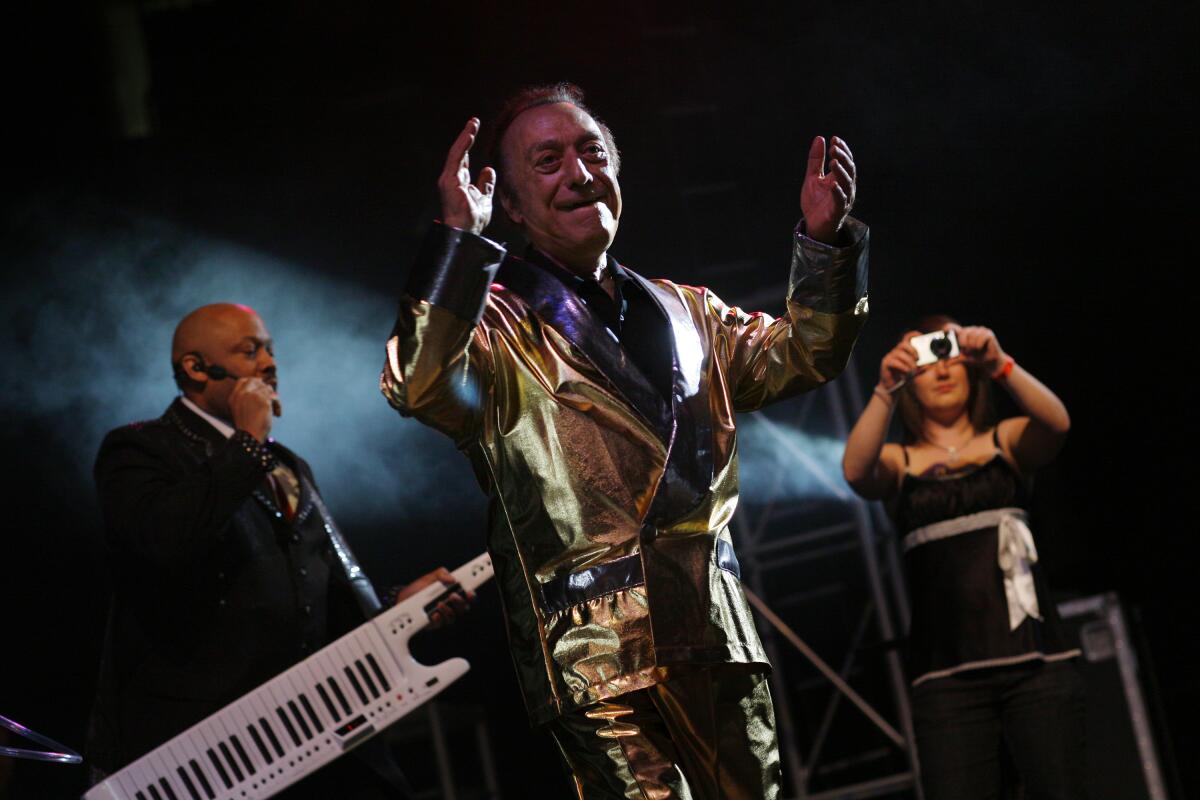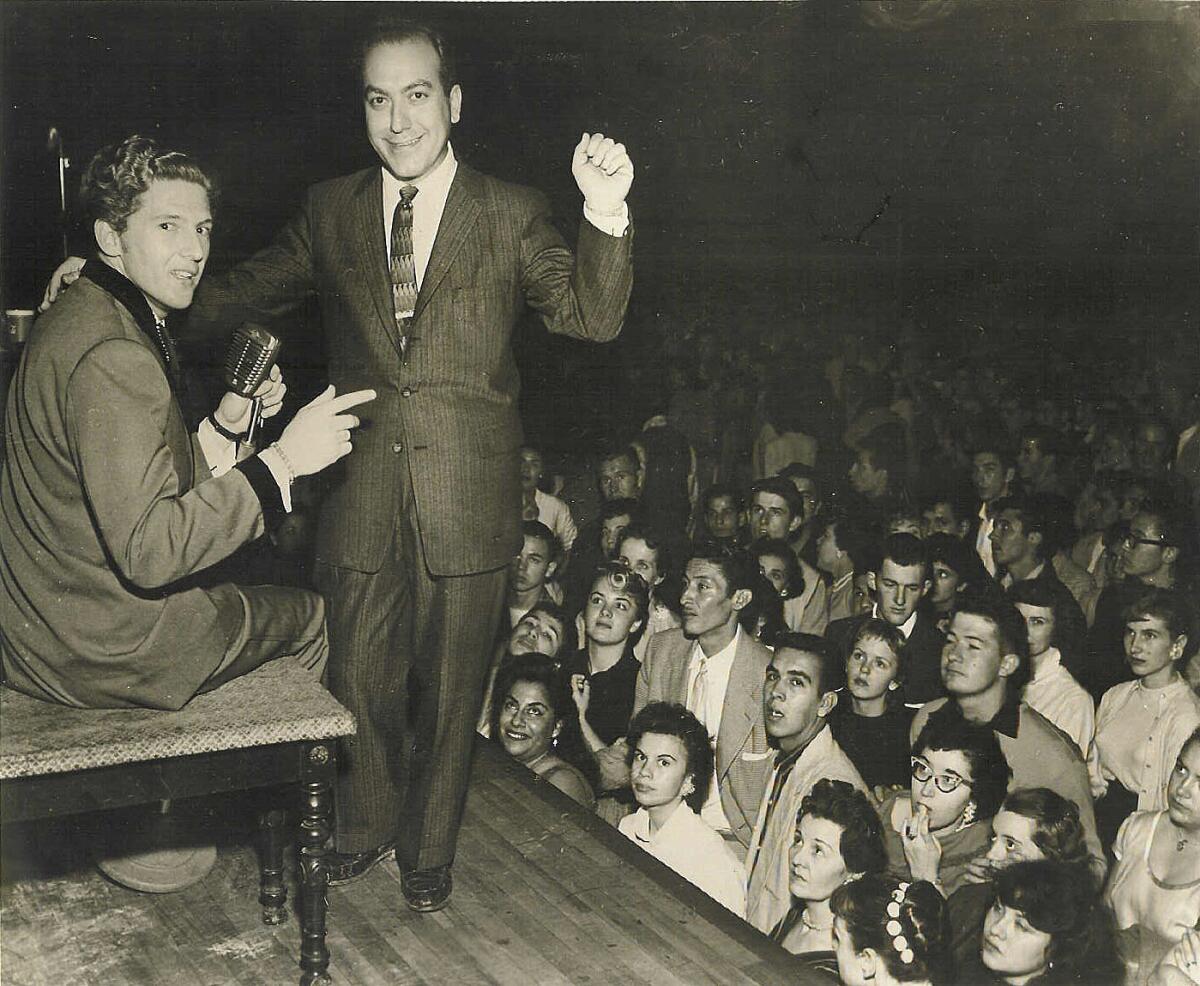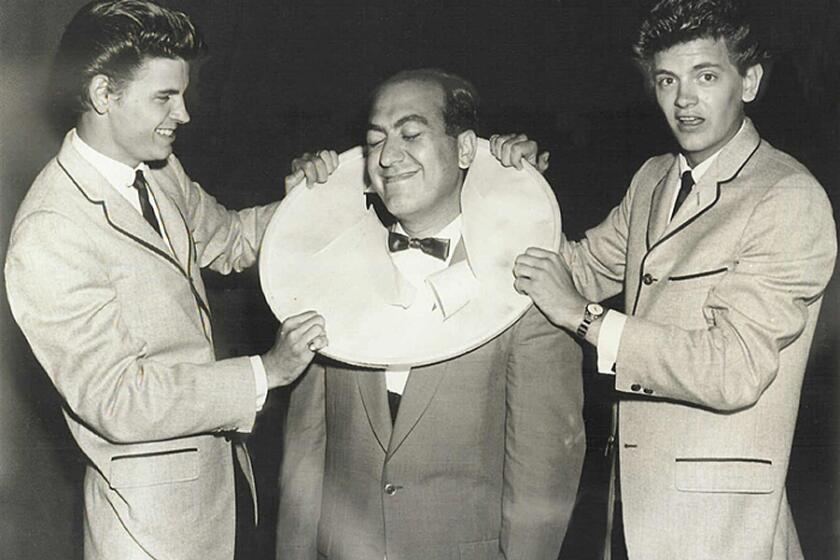Art Laboe dies; his ‘Oldies but Goodies’ show ruled the L.A. airwaves

- Share via
When Art Laboe was a child, his mother couldn’t pull him away from the radio.
“I listened to soap operas. I listened to news. I listened to all the announcements,” he told The Times in 2009. “I was enthralled with this box that talked.”
The disc jockey, who got his first radio job at 17, went on to fill Southern California’s airwaves for more than 70 years. He was one of the first to play rock ’n’ roll on the West Coast and was a pioneer in creating a compilation album, calling it “Oldies but Goodies.”
His inviting, baritone voice became a beacon for generations of fans, particularly Latinos.
Behind a microphone until late in life, Laboe died late Friday while battling pneumonia, Joanna Morones, a spokesperson for Laboe’s production company, said. He was 97.
From KCRW to Power 106, here’s how the local radio community is honoring Art Laboe, the radio titan who died Friday at age 97.
Through the decades, his nighttime love song and dedication show endured unchanged in a sea of constant radio format shifts.
Listeners would call in from Oxnard, Boyle Heights, Riverside; from as far as Phoenix, Albuquerque and Nevada. They were lovers, loners, kids and grandmothers — some who had tuned in since grade school.
Laboe helped them celebrate anniversaries, mourn the loss of loved ones and profess their love. He played intermediary in arguments and blew kisses on birthdays.
His radio program consistently ranked near the top evening time slots and was syndicated in more than a dozen cities, drawing about a million listeners per week. His show was broadcast in Los Angeles for more than 20 years on Hot 92.3 (KRRL-FM).
“He was the voice of the real L.A.,” said Lou Adler, the famed record producer, manager and hardcore Laboe fan. “He reached out and touched people growing up in this melting pot. He cut right through it and understood us.”

Laboe was born Art Egnoian in Salt Lake City on Aug. 7, 1925, in the same decade commercial radio broadcasting began. He was a loner growing up, he said in a Times profile, a small Armenian kid who “wasn’t a big, good-looking hunk.”
His parents divorced when he was 13 and he moved to South Los Angeles to live with his sister. He started his own amateur radio station in 1938 out of his bedroom. Over the airwaves he was anonymous, and listeners, he was pleased to find, were drawn to his voice.
He attended Stanford University and, after a stint in the Navy during World War II, scored his first job at a station in San Francisco. A general manager encouraged him to adopt the last name Laboe because it sounded catchier.
By the time he returned to Los Angeles in the 1950s, rock ‘n’ roll was beginning to make its furious ascent. Laboe, a plainspoken man with sharp business instincts, dove in and promoted the music.
After more than 50 years on the radio, the disc jockey is still going strong, playing sentimental songs and taking dedications. His deep, soothing voice is cherished by his Latino listeners.
He broadcast his show live from Scrivner’s Drive-In at Sunset and Cahuenga boulevards, and teenagers showed up in droves to watch, creating traffic jams around the classic hamburger joint.
As the crowd grew, he would lean in to the microphone and say, “Hey mothers, gather up your daughters. Here comes Art Laboe and his devil music.”
His audience grew so large at the drive-in that Laboe began to host dance shows. The city of Los Angeles did not allow public dances for those under 18 at the time so he headed to the El Monte Legion Stadium.
There, up to 3,000 fans would gather every other week to dance away to rising stars such as Sam Cooke, Ritchie Valens and Jackie Wilson. Laboe used to greet fans at the door and help them out with 50-cent pieces if they were short on money.
“It was like a tidal wave, and kids went nuts for it,” Laboe told LA Weekly in 2005.
Concertgoers formed a rainbow of colors: white fans from the Westside, Black listeners from South L.A. and Latino fans from the Eastside.
Until the end, many of those Latino listeners — their children and grandchildren — remained devoted fans.
“He is more Chicano than some Chicanos,” comedian Paul Rodriguez said in 2009. “And everyone from the toughest vato to the wimpiest guy would say the same.”

During his Scrivner’s days, Laboe noticed that listeners often gravitated to oldies, songs that were 4 or 5 years old. He began calling them “Oldies But Goodies,” a phrase he later trademarked as other broadcasters began to borrow it.
In 1959, he took the concept and commercialized it, creating one of the first compilation albums of oldies music. His first volume (there were 15 total) stayed on the Billboard Top 100 chart for more than three years.
Those collections, along with his radio show, promoted countless music groups that may have otherwise been forgotten: the Shirelles, the Platters, Eddie Holman, Brenton Wood.
“You don’t replace people like Art Laboe,” said author-historian Harvey Kubernik. “His reach was monumental. He was a disc jockey, program director, concert promoter, label owner, columnist.”
His deep, soothing voice had filled Los Angeles’ airwaves for more than 60 years.
Laboe rarely took a day off. He used to love working holidays because that’s when the best — and often the most sentimental — dedications came in.
For years he ran his show inside his dimly lighted Hollywood studio, home of his record label, Original Sound. His star on the Hollywood Walk of Fame was just a few blocks away on the corner of Hollywood Boulevard and Highland Avenue.
In his studio, he used to ease into his leather chair just before 7 p.m. to watch phone lines flash with callers. Laboe chatted with each fan and read their dedications on the air:
“Her name is Ana Ivette Vasquez and I want to let her know that I’m really sorry for doing her wrong, for all the tears she dropped and pain I put her through. I want to dedicate this song from deep down in my heart.”

He estimated that about half of his callers were Latino. Some had loved ones locked up in prisons in places like Chino, Delano and Calipatria. Others had nicknames like Mr. Porky, Lil’ Crazy, Bugsy and Payasa.
Laboe never judged them.
“Here’s somebody,” he said to The Times, “who might feel that what they have going on is of little importance in life and now they come on the radio and their voice goes out to the whole world.”
Latino fans loved him the way Lakers fans loved the colorful play-by-play calling of Chick Hearn. They filled his annual concerts by the thousands and made him part of the emerging Chicano identity. He was the only non-Latino ever selected as grand marshal of the East L.A. Christmas Parade. And he had such a connection to El Monte that the city proclaimed March 10 Art Laboe Day and erected a fountain in his honor at the site of the long ago demolished Legion Stadium
In the early 1970s, even future Mayor Antonio Villaraigosa said he used to cruise through Boyle Heights in his canary-yellow 1964 Chevy, bumping Laboe’s music.
“His show was the first place a young Chicano kid had to air his feelings, the first place you could say something and be heard,” said Ruben Molina, author of two books on Chicano music and American culture.

Off the radio, Laboe lived a mostly quiet life. He lived alone in a house in the Hollywood Hills and enjoyed eating at the Chateau Marmont, where everybody seemed to know him. He moved to Palm Springs in 2015 when his broadcast moved to KDAY-FM (93.5).
His family, he used to say, were his listeners.
Approaching 90, he remained healthy and active, doing push-ups and pull-ups. And he still came on the radio every Sunday evening with “The Art Laboe Connection Show,” which he began broadcasting from his home when the COVID-19 pandemic began. He had been set to broadcast one of his signature DJ concerts last Saturday at Glen Helen Amphitheater in San Bernardino.
Retirement seemed out of the question.
“Radio,” he told The Times, “is my life.”
More to Read
Sign up for Essential California
The most important California stories and recommendations in your inbox every morning.
You may occasionally receive promotional content from the Los Angeles Times.

















